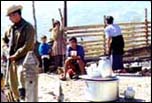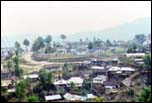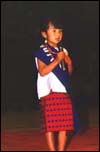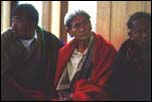Guns and Roses
... a visit to Nagaland
Text and photographs: Samuel Jacob
 From the sky the tin roofs below appear like solar panels scattered amidst patches of paddy, as the plane descends towards Dimapur, the ‘Gateway of Nagaland’. These geometric shapes hold your attention whenever, momentarily, the plane breaks free of the clouds. Till then, as the plane cut a swathe for an hour and twenty minutes across
Assam, the landscape is monotonous. From the sky the tin roofs below appear like solar panels scattered amidst patches of paddy, as the plane descends towards Dimapur, the ‘Gateway of Nagaland’. These geometric shapes hold your attention whenever, momentarily, the plane breaks free of the clouds. Till then, as the plane cut a swathe for an hour and twenty minutes across
Assam, the landscape is monotonous.
The February air in Dimapur is not as chilly as one expects of a town belonging to this forested hill paradise, perched on the border of Myanmar. Of course, it is half-past-two in the afternoon when the plane lands and the sun has kept the air pleasantly warm. Dimapur airport
is unlike other airports. It is small by any standards, with a single runway and a small building to one side. Probably that is all the infrastructure that is required to handle the odd flight in days.
As you step onto the tarmac, the first sight that grabs your attention is the ornate portico to the airport building. Made of wood and bamboo, the exquisite and typically Naga structure stands awkwardly amidst concrete and contradictions. At the entrance to this magnificent edifice, a Kalashnikov-wielding jawan scours every face that passes through, reminding you: This is no paradise, but apparently the `heartland of insurgency'.
 The airport area is crawling with heavily armed army personnel. A sniffer dog ambles about with a bored expression, led by a master who looks even more bored. My elation gives way
to more subdued feelings. Apparently, the tarmac and airport building is given a `security cordon' every time a plane lands. And after the plane takes off, the cordon disappears into the army cantonment adjacent to the airport.
Gateway to Nagaland is an apt name for Dimapur -- all air, rail and road routes to
the state meet here. Since travelling by rail would entail a two-day journey from Calcutta, it is preferable to catch
the Indian Airlines flight from Calcutta that goes via Jorhat in Assam, if one can afford the subsidised fare of Rs 2,455.
The 74-km run from Dimapur to Kohima, the capital of Nagaland,
by bus takes over two hours. It is a steady climb from 585 ft above sea level to 4,232 ft and the road is liberally strewn with potholes and rubble.
As Dimapur flits past, I get the picture of a ragtag, hodgepodge city that could be any other upcoming unplanned urban conglomeration in India. Except that here, every few hundred
yards, men in army fatigues, with their heads and faces covered in black cloth, like bandits, peer from behind sand bunkers, their AKs and LMGs seeking a target. I am thankful to leave these `troubled plains' behind and head for the hills.
 Paddy covered landscapes and bamboo huts flee past my eyes. Realisation dawns that the `solar panels' seen from the skies are nothing but tin roofs of the bamboo huts. Tin,
for whatever reason, is a popular material for roofs here. Paddy covered landscapes and bamboo huts flee past my eyes. Realisation dawns that the `solar panels' seen from the skies are nothing but tin roofs of the bamboo huts. Tin,
for whatever reason, is a popular material for roofs here.
All along the route huge hoardings bombard you with messages against AIDS and drugs -- a major social concern in these parts. There are also messages urging the population to grow more trees -- another concern, given that jhum (slash and burn) cultivation is widely practised in these parts.
When we arrive, Kohima is cold and dark at five in the evening. The streets
are almost deserted and the shops closed. Only army personnel
are about. Luckily, the bus is stopped only once for checks -- a
regular `hazard' for travellers in Nagaland.
Hotel Japfu is my destination for the next few days. Located on a hill overlooking the city, its rooms have a fine view from all sides. The hotel is named after the Japfu mountain, the second highest peak in Nagaland at 9,144 ft and located 15 km south of Kohima (the highest peak in Nagaland is Mount Saramati
at 11,523 ft in Kiphire division of Tuensang district touching
the Indo-Myanmar border).
 The sun is up by 5 am in Kohima and sets by 5 pm. However, life is at its peak only for a few hours during the day. By 3 pm most shops have downed shutters and people try to keep indoors. Decades of tension and conflict due to the movement for freedom from India have dampened the enthusiasm of the Naga people towards socialising. This does not mean they are a dull
lot. On the contrary, to the visitor they come across as a cheerful people; full of life and enthusiasm for life... beautiful people with value for words and words of value. Evocative and eloquent in their discourses, they exude passion while talking of their troubled land and battered souls. The sun is up by 5 am in Kohima and sets by 5 pm. However, life is at its peak only for a few hours during the day. By 3 pm most shops have downed shutters and people try to keep indoors. Decades of tension and conflict due to the movement for freedom from India have dampened the enthusiasm of the Naga people towards socialising. This does not mean they are a dull
lot. On the contrary, to the visitor they come across as a cheerful people; full of life and enthusiasm for life... beautiful people with value for words and words of value. Evocative and eloquent in their discourses, they exude passion while talking of their troubled land and battered souls.
 This underlying pathos may be one reason for the very high incidence of alcoholism and drug abuse among the otherwise exuberant population. Promiscuity
has delivered another fatal blow to the society -- AIDS. Actually, a few days in Nagaland and even you end up spending the evenings with the bottle for company -- the days are short and nights long and there are hardly any other avenues for entertainment. This underlying pathos may be one reason for the very high incidence of alcoholism and drug abuse among the otherwise exuberant population. Promiscuity
has delivered another fatal blow to the society -- AIDS. Actually, a few days in Nagaland and even you end up spending the evenings with the bottle for company -- the days are short and nights long and there are hardly any other avenues for entertainment.
|

